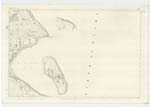OS1/6/3/142
| List of names as written | Various modes of spelling | Authorities for spelling | Situation | Description remarks |
|---|---|---|---|---|
| ST MOLIO'S CAVE | St Molio's Cave St Molio's Cave St Molio's Cave St. Molingus, Maeljos, or Molios Cave St Molio or Maoliosa St Maol Ios |
New Stat Acct. [Statistical Account] McArthur's Antiquities Estate Map Origines Parochiales Wilson's Archaeology. Fullarton's Gazetteer |
250 | "St Molio's Cave" is situate on the western side of the island, And is a natural excavation in the old sea cliff "The legend of St. Lasrian, or Molassus, is well Known to Irish Antiquaries; It was printed in the Bollandists' Collection, "Acta Sanctorum", He was born in Ireland. A.D. [Anno Domini] 566 educated in Bite by his uncle St Blaan, returned for some years to Ireland, and afterwards, when yet only twenty years of age retired to an island in Scotland where for some years he led the life of a hermit (probably in the cave which is still pointed out as his in Lamlash Isle, i.e. Isle-a-Molass. later named the "Holy Isle", About the year 614 he was elected Abbot of Leighlin, in Ireland, and was afterwards made Bishop and Apostolic legate to the church in Ireland, he died in the year 640 A large square stone in front of the cave is called the Saint's table, and beside it, a pure spring of water, which was long famous for supposed healing qualities, "The cave of St Molio is little more than a waterworn recess in the sandstone rock at an elevation of about 30 feet from the present level of the sea. On the shore below a circular well is pointed out as St. Molio's Bath & a large block of sandstone cut perfectly flat on the top & surounded with a series of artificial recesses or seats, bears the name of the Saint's Chair. The roof & sides of the cave are covered with rude marks and inscriptions of many different periods" Wilson's Archaeology. "Buchanan gives this the latin name of Molas or Molassa from its having been the retreat of St. Maol-jos for the same reason it is called the holy Island - St Maol-jos's Cave the residence of that holy man, his well of most salutary water, a place for bathing, his chair, and the ruins of his chapel are shown to strangers." Pennant's Tour of 1772 p [page] 214. "The cave of St Molios, in the Holy Isle, Molios (or, as the name means in Gaelic, the shaved servant of Jesus) was a disciple of St. Columba, who, not considering the discipline of Iona sufficiently rigid, retired for greater seclusion to this lonely isle, whence he diffused the light of Christianity among the formerly Pagan inhabitants of Arran The cave which formed his residence is merely an excavation in the red Sandstone, hollowed out by the sea, when its level was higher then at present. On the roof of the cave is a Runic inscription stating the name & office of the Saint & a little raised above its floor, a shelf of rock, said to have been his bed. In the neighbourhood of the cave there is a flat stone called his dining table & a pure spring of water (his bath) much resorted to for its healing virtues" New Stat[Statistical] Account. |
Continued entries/extra info
[page] 142 - 14Parish of Kilbride
Transcribers who have contributed to this page.
DANIALSAN, Chr1smac -Moderator, Brenda Pollock
Location information for this page.




